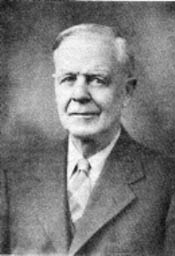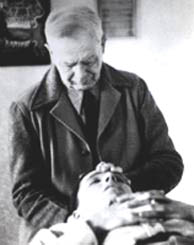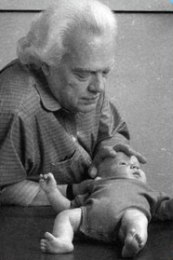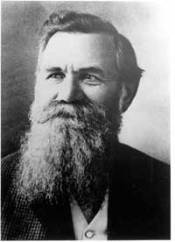"Find it, fix it, and leave it alone." A.T. Still, M.D.
History of Craniosacral Therapy
Dr. Andrew Taylor Still
 Craniosacral Therapy has its roots in the work of Andrew Taylor Still, M.D. (1828-1917). His father was a Methodist preacher and physician who instilled in Andrew the beliefs that all men were created equal and that alcohol abuse could lead to destructive ends. By 1861, Andrew was married with three children and living in Kansas. The American Civil War was underway and Andrew enlisted as a doctor where he saw firsthand the horrors of war. During this time, an epidemic of meningitis swept through the country and wiped out his family. One question that haunted A.T. Still was whether the meningitis itself or the mercury based medication- mercury chloride- chosen to treat the disease was the deciding factor which killed his family. His inability to help his family, plus the horrors he witnessed in the war and its aftermath, seeing so many men in so much pain and suffering addicted to morphine and/or alcohol, brought about a recognition that there must be a better way of treating the sick and dying. The loss of his family devastated Andrew and placed him in a severe depression. During this time, he became open to new ideas about nature and natural laws. Andrew, even as a young boy, was fascinated by the anatomy of animals and the function of machines, which led him later to delve deeper into anatomy and physiology and the relationship of form and function that would be the foundation of his new system of healthcare which he would later name Osteopathy.
Craniosacral Therapy has its roots in the work of Andrew Taylor Still, M.D. (1828-1917). His father was a Methodist preacher and physician who instilled in Andrew the beliefs that all men were created equal and that alcohol abuse could lead to destructive ends. By 1861, Andrew was married with three children and living in Kansas. The American Civil War was underway and Andrew enlisted as a doctor where he saw firsthand the horrors of war. During this time, an epidemic of meningitis swept through the country and wiped out his family. One question that haunted A.T. Still was whether the meningitis itself or the mercury based medication- mercury chloride- chosen to treat the disease was the deciding factor which killed his family. His inability to help his family, plus the horrors he witnessed in the war and its aftermath, seeing so many men in so much pain and suffering addicted to morphine and/or alcohol, brought about a recognition that there must be a better way of treating the sick and dying. The loss of his family devastated Andrew and placed him in a severe depression. During this time, he became open to new ideas about nature and natural laws. Andrew, even as a young boy, was fascinated by the anatomy of animals and the function of machines, which led him later to delve deeper into anatomy and physiology and the relationship of form and function that would be the foundation of his new system of healthcare which he would later name Osteopathy.
As time passed, Andrew grew to reject the common practices of frequent amputations and the over-prescribing of drugs. As he continued to explore the anatomy and mechanics of the human body, he realized the inter-relationship of the whole person with its parts, that form and function were intimately connected and that the body had the ability to self regulate and self heal. While Andrew became more outspoken about his new found convictions of healthcare, many of his fellow doctors felt the system was fine and nothing needed to change. This led to considerable opposition to what he was proposing. Even his brothers, also doctors, were embarrassed that he questioned the conventional medical wisdom of the day and the Methodist Church felt his methods of hands-on healing were sacrilegious. Andrew's quest to establish his new form of medicine and have a decent practice in a town to support his family was to be severely challenged. If not for his wife's unfailing support, his sense of spirituality and his conviction that he could help his fellow man in a better way, he would surely have fallen into great despair. After he moved to Kirksville, Missouri he worked on a local preacher’s daughter and after restoring her health, people welcomed Still’s new brand of medicine. By 1885, at the age of 57, word started to spread about Dr. A.T. Still's drugless, manual medicine which had helped many apparently hopeless cases.
 On October 3, 1892, after 18 years of practicing osteopathy, he opened the American School of Osteopathy in Kirksville, Missouri, and the first graduating class included 21 students, of note- five were women and sixteen men, three of whom were Still's own children. In 1917, at the age of 89, the "old doctor" passed away, leaving behind him a legacy of over 3,000 osteopathic physicians at that time. Osteopathic training became a 4- year program just like allopathic medicine (M.D.) and right after Dr. Still died, they introduced drugs and medications into the osteopathic curricula for which Dr. Still had fought so long and hard to keep out. Out of the 950,000 doctors in the US, 6% are osteopaths and out of all the osteopaths in America, less than 7% actually do manual therapy in their practice.
On October 3, 1892, after 18 years of practicing osteopathy, he opened the American School of Osteopathy in Kirksville, Missouri, and the first graduating class included 21 students, of note- five were women and sixteen men, three of whom were Still's own children. In 1917, at the age of 89, the "old doctor" passed away, leaving behind him a legacy of over 3,000 osteopathic physicians at that time. Osteopathic training became a 4- year program just like allopathic medicine (M.D.) and right after Dr. Still died, they introduced drugs and medications into the osteopathic curricula for which Dr. Still had fought so long and hard to keep out. Out of the 950,000 doctors in the US, 6% are osteopaths and out of all the osteopaths in America, less than 7% actually do manual therapy in their practice.
In the United States, A.T. Still was the first to identify the human immune system and develop a system to stimulate it naturally. He was the first to openly accept women and minorities into his school of Osteopathy (in 1892), believed that the body was holistic and that a disease process in one part of the body could affect another part, and predicted that the United States would have a major drug problem if physicians did not stop over-prescribing addictive drugs.
Dr. William Garner Sutherland
 William Garner Sutherland, D.O. (1873-1954) is credited as the originator of osteopathy in the cranial field, commonly known today as Craniosacral Therapy. Sutherland was born in Wisconsin; his father was a blacksmith and his mother a homemaker. He was the third of four children and as a child, had a curious and insightful mind. He was very interested in how things worked and at a young age, took a job as a newspaper reporter. Sutherland would often comment that this gave him a critical eye toward information without prejudice or emotion. Will was asked by the paper to do a story on Dr. Still's drugless manual therapy. So impressed by what he saw in Kirksville, that in 1898 at the age of 25, Sutherland enrolled in A.T. Still’s School of Osteopathy, which was a 2-year program by this time. While a student there, he became fascinated with the idea of form and function. Looking at a disarticulated skull where the sphenoid and temporal bones articulated, Sutherland noticed it appeared to him as the gills of a fish, and the thought struck him that it was designed for motion. When Sutherland asked Still if the head had motion available, Still replied, "It has to, to be able to accommodate for movement." Sutherland realized that if the bones of the skull were designed for motion, then restrictions would inhibit health, which would lead eventually to pain and disease. Using Still’s osteopathic model, Sutherland pursued his interest in testing his ideas on skull motion by courageously performing experiments on himself. After many years of trial and error he was confident enough to use these techniques on his patients with great success.
William Garner Sutherland, D.O. (1873-1954) is credited as the originator of osteopathy in the cranial field, commonly known today as Craniosacral Therapy. Sutherland was born in Wisconsin; his father was a blacksmith and his mother a homemaker. He was the third of four children and as a child, had a curious and insightful mind. He was very interested in how things worked and at a young age, took a job as a newspaper reporter. Sutherland would often comment that this gave him a critical eye toward information without prejudice or emotion. Will was asked by the paper to do a story on Dr. Still's drugless manual therapy. So impressed by what he saw in Kirksville, that in 1898 at the age of 25, Sutherland enrolled in A.T. Still’s School of Osteopathy, which was a 2-year program by this time. While a student there, he became fascinated with the idea of form and function. Looking at a disarticulated skull where the sphenoid and temporal bones articulated, Sutherland noticed it appeared to him as the gills of a fish, and the thought struck him that it was designed for motion. When Sutherland asked Still if the head had motion available, Still replied, "It has to, to be able to accommodate for movement." Sutherland realized that if the bones of the skull were designed for motion, then restrictions would inhibit health, which would lead eventually to pain and disease. Using Still’s osteopathic model, Sutherland pursued his interest in testing his ideas on skull motion by courageously performing experiments on himself. After many years of trial and error he was confident enough to use these techniques on his patients with great success.
 In 1927, Dr. Sutherland married Adah Strand, who was a tremendous support to him and encouraged him to get this important work out to his colleagues. By the mid 1930’s, Sutherland’s work became more refined. His interest now moved beyond bone and into fascial membranes, the central nervous system and the cerebrospinal fluid and its influence all the way to the sacrum. In an extemporaneous talk entitled "A Tour of the Minnow", first presented in the late 1940's, Dr. Sutherland took listeners on an imaginary tour through the living brain and asked the practitioner to pay attention to key anatomical landmarks inside and out of the brain and spinal cord. What Sutherland talked about was subtle and required discipline and patience to acquire, and because of this, people again were quick to criticize his work. However, his clinical results were now so dramatic and interest from colleagues increased that he continued to move forward with his work. By the mid 1940’s, Sutherland starts utilizing lighter and more delicate forces in his work and had the awareness that when fluids are inhibited, this had an effect on the entire central nervous system and thus, the body. By 1946, Sutherland’s work had now attracted such a large following that an organization was begun known as the Cranial Academy, which promoted continued research in the field of osteopathy. By 1953, Will established the Sutherland Cranial Teaching Foundation as an organization to continue the teachings of his cranial work. In 1954, at the age of 81, W.G. Sutherland, D.O., passed from this world, leaving a legacy of important work for people to discover for many years to come.
In 1927, Dr. Sutherland married Adah Strand, who was a tremendous support to him and encouraged him to get this important work out to his colleagues. By the mid 1930’s, Sutherland’s work became more refined. His interest now moved beyond bone and into fascial membranes, the central nervous system and the cerebrospinal fluid and its influence all the way to the sacrum. In an extemporaneous talk entitled "A Tour of the Minnow", first presented in the late 1940's, Dr. Sutherland took listeners on an imaginary tour through the living brain and asked the practitioner to pay attention to key anatomical landmarks inside and out of the brain and spinal cord. What Sutherland talked about was subtle and required discipline and patience to acquire, and because of this, people again were quick to criticize his work. However, his clinical results were now so dramatic and interest from colleagues increased that he continued to move forward with his work. By the mid 1940’s, Sutherland starts utilizing lighter and more delicate forces in his work and had the awareness that when fluids are inhibited, this had an effect on the entire central nervous system and thus, the body. By 1946, Sutherland’s work had now attracted such a large following that an organization was begun known as the Cranial Academy, which promoted continued research in the field of osteopathy. By 1953, Will established the Sutherland Cranial Teaching Foundation as an organization to continue the teachings of his cranial work. In 1954, at the age of 81, W.G. Sutherland, D.O., passed from this world, leaving a legacy of important work for people to discover for many years to come.
Dr. Harold Ives Magoun
 Harold I. Magoun, Sr., D.O., F.A.A.O. (1898-1981) was one of Sutherland's first generation students, a dedicated teacher and has contributed greatly to the ongoing field of cranial osteopathy as author/editor of Osteopathy in the Cranial Field. The first edition was written in 1951 while Dr. Sutherland was still alive. Dr. Magoun put together a compilation of the cranial techniques and models as a resource for students practicing this form of manual osteopathy. This book is important because it lays out Dr. Sutherland's thoughts on cranial osteopathy in a clear and concise way. It is the text used by the the Cranial Academy and SCTF, which are only open to MD's, DO's and DDS's. It was only recently made available for sale to the general public. In his later years, Dr. Magoun published more than two-dozen articles and another book, Practical Osteopathic Procedures.
Harold I. Magoun, Sr., D.O., F.A.A.O. (1898-1981) was one of Sutherland's first generation students, a dedicated teacher and has contributed greatly to the ongoing field of cranial osteopathy as author/editor of Osteopathy in the Cranial Field. The first edition was written in 1951 while Dr. Sutherland was still alive. Dr. Magoun put together a compilation of the cranial techniques and models as a resource for students practicing this form of manual osteopathy. This book is important because it lays out Dr. Sutherland's thoughts on cranial osteopathy in a clear and concise way. It is the text used by the the Cranial Academy and SCTF, which are only open to MD's, DO's and DDS's. It was only recently made available for sale to the general public. In his later years, Dr. Magoun published more than two-dozen articles and another book, Practical Osteopathic Procedures.
Dr. John Edwin Upledger
 John E. Upledger, D.O., O.M.M., (1932-2012), creator and developer of craniosacral therapy, was one of Dr. Magoun's students, and my teacher. He is co-author with Jon Vredevoogd, M.F.A., of Craniosacral Therapy and many other texts on craniosacral therapy. Dr. Upledger became aware of a course in cranial osteopathy in 1968 offered by The Cranial Academy and taught by Dr. Magoun. As John delved deeper into the cranial osteopathic field, an opportunity presented itself in 1975 that allowed him to further develop his skills at the Michigan State University College of Osteopathic Medicine. While at MSU, some disagreements arose between Dr. Upledger and Dr. Becker of the Sutherland Cranial Teaching Foundation and by the time Dr. Upledger and Vredevoogd's book was published in 1983, Dr. Upledger was no longer associated with either the Cranial Academy or the SCTF.
John E. Upledger, D.O., O.M.M., (1932-2012), creator and developer of craniosacral therapy, was one of Dr. Magoun's students, and my teacher. He is co-author with Jon Vredevoogd, M.F.A., of Craniosacral Therapy and many other texts on craniosacral therapy. Dr. Upledger became aware of a course in cranial osteopathy in 1968 offered by The Cranial Academy and taught by Dr. Magoun. As John delved deeper into the cranial osteopathic field, an opportunity presented itself in 1975 that allowed him to further develop his skills at the Michigan State University College of Osteopathic Medicine. While at MSU, some disagreements arose between Dr. Upledger and Dr. Becker of the Sutherland Cranial Teaching Foundation and by the time Dr. Upledger and Vredevoogd's book was published in 1983, Dr. Upledger was no longer associated with either the Cranial Academy or the SCTF.
When Dr. Upledger left Michigan State he revolutionized the cranial osteopathic work by offering courses to everyone in the healthcare field, sharing important research in the cranial work as someone who had been inside the academy, and developing new techniques such as the temporal decompression, arcing, vectors, and whole body unwinding. He integrated the cranial techniques of cranial osteopathy with other osteopathic manual modalities, most notably myofascial release and unwinding, which when combined together, became craniosacral therapy.
Another notable contribution of Dr. Upledger has been his exploration and encouragement of the emotional-physical connection of the body in whole body unwinding, mouth work and dialogue techniques . This openness to exploring the mind-body connection was a natural unfolding for John as his Bachelor's Degree from Wayne State was in Psychology. He is credited with renewing interest in the cranial osteopathic work of Sutherland. However, confusion has arisen in the last few decades as to the origination of the cranial concepts and since there is no mention of Dr. Magoun, the Cranial Academy, or the Cranial Teaching Foundation in any of Dr. Upledger's books, the source of the field remains a bit hazy and incomplete to the general public and even most UI alumni. Dr. Upledger retired from active clinic work, administrative duties and teaching in 2008 and passed away in 2012.
Others of Note
Daniel David Palmer, D.C. (1845-1913) was a friend of Obie Stothers, one of Dr. Still's students. Stothers returned to the school in 1894 with Palmer, a Canadian who practiced magnetic healing in Davenport, Iowa. Palmer came specifically to take treatment from Dr. Still and his students and had many conversations with Dr. Still over the next few weeks. Palmer returned to Iowa and in 1895, started his own practice of manipulative medicine. A friend by the name of Samuel Weed coined the term chiropractic, meaning "done by hand." Palmer realized early on that Still faced a growing conflict in his own school by the staff of M.D.’s, who from the very beginning, wanted to bring an allopathic viewpoint, including drugs into the osteopathy curriculum. In 1897, he accepted his first students at the Palmer School & Infirmary of Chiropractic. Very few American osteopaths today in the 21st century practice in the traditions of Dr. Still. However, Dr. Palmer’s vision of manipulative medicine has actually stayed truer to the fundamentals of Dr. Still’s vision of osteopathy than osteopathy itself.
practiced magnetic healing in Davenport, Iowa. Palmer came specifically to take treatment from Dr. Still and his students and had many conversations with Dr. Still over the next few weeks. Palmer returned to Iowa and in 1895, started his own practice of manipulative medicine. A friend by the name of Samuel Weed coined the term chiropractic, meaning "done by hand." Palmer realized early on that Still faced a growing conflict in his own school by the staff of M.D.’s, who from the very beginning, wanted to bring an allopathic viewpoint, including drugs into the osteopathy curriculum. In 1897, he accepted his first students at the Palmer School & Infirmary of Chiropractic. Very few American osteopaths today in the 21st century practice in the traditions of Dr. Still. However, Dr. Palmer’s vision of manipulative medicine has actually stayed truer to the fundamentals of Dr. Still’s vision of osteopathy than osteopathy itself.
Randolph Stone, D.O., D.C., N.D., (1890-1981) developed his unique system of Polarity therapy based on Ayurvedic, yogic, cabalistic, hermetic and alchemic ancient traditions of natural healing. Having degrees in osteopathy, chiropractic, and naturopathic medicine, he had an excellent balance between Western hard sciences and Eastern energetic concepts. He practiced in
Chiropractors have SOT exclusively available to them as an elective in most of their schools where there are also SOT clubs. Many chiropractors take craniosacral therapy classes outside of school and make up a substantial group of therapists who practice this form of therapy throughout the United States and around the world. SOT techniques and CST techniques will appear dramatically different in approach and application to the student of cranial therapy. In CST, no props or tools are utilized, no active muscle testing is applied and no thrust techniques are used during the session. Also, there are preliminary protocols that must be applied before the CST practitioner is able to actually perform techniques on the cranium. Blending with the client, allowing the body to move at its own pace and being patient in waiting for corrections/releases all take time and chiropractors who have high-volume practices will not be able to apply the CST techniques in a manner that befits the patient or the therapy.
